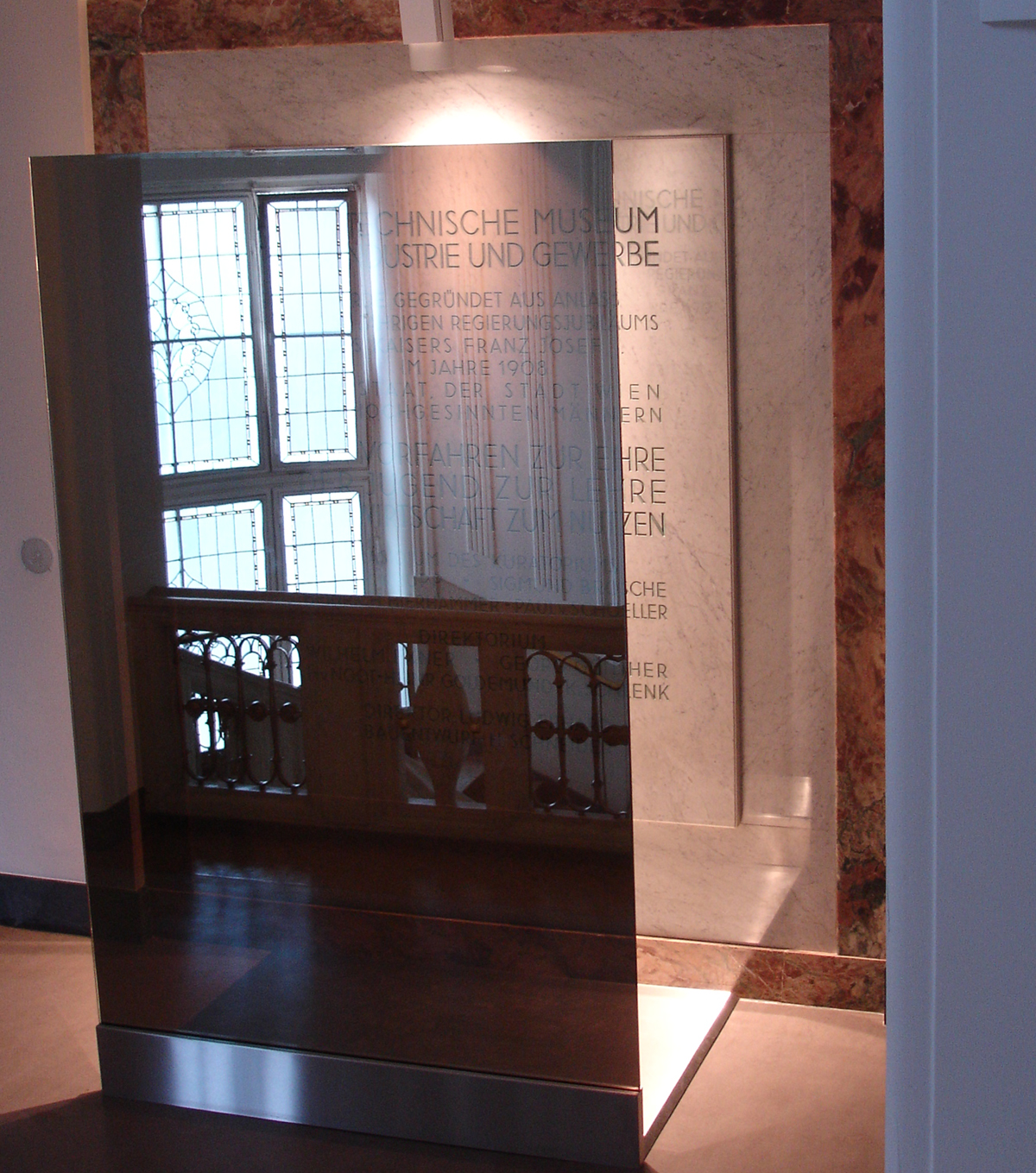NAMELESS
three-part installation
three-part installation
three-part installation: panel of glass, sound installation and the video Pendel / 2009
The plaque (panel, roll of honor) in the Technical Museum Vienna commemorates the museum's founders and benefactors. Few people know that in 1925 there was a different plaque mounted there. In 1942 they had the first stone plaque removed because of two Jewish names, and replaced with a new one bearing none of the founders' and patrons' names.
The artist Miriam Bajtala renders this act visible with a multimedia intervention. First she engages with the plaque's location, the stairwell: it is a core area for access but is hardly a place to think nor inviting to linger in. Then she brings the plaque's history to life with striking excerpts from the official records. Her intervention subtly draws attention to the plaque's location and makes an experience of its history. (text: 100 Jahre Technisches Museum Wien)
1: one-way mirror, glass object
Mounted approx. 100 cm in front of the plaque: an 18mm-thick glass panel the same size as the plaque that was put up in 1942 (231cm x 170cm). Coming from the side of the stairs the glass is no longer transparent, and is perceived as a 'filter' between the viewer and the plaque. Coming from the plaque, when the viewer stands between the plaque and the glass object, the object becomes a mirror (a one-way mirror). People looking in the mirror see themselves with the commemorative plaque behind them.
2: sound installation:
Excerpts from the official report from 1942 are read aloud by speech-recognition software (avatar). The mechanical, pseudo-human, unemotional voice reads from the minutes, saying that the Jewish names are "a public nuisance" and must accordingly be removed. The mechanically spoken text also links to the film in which the wall with the plaque is permanently being scanned.
The plaque (panel, roll of honor) in the Technical Museum Vienna commemorates the museum's founders and benefactors. Few people know that in 1925 there was a different plaque mounted there. In 1942 they had the first stone plaque removed because of two Jewish names, and replaced with a new one bearing none of the founders' and patrons' names.
The artist Miriam Bajtala renders this act visible with a multimedia intervention. First she engages with the plaque's location, the stairwell: it is a core area for access but is hardly a place to think nor inviting to linger in. Then she brings the plaque's history to life with striking excerpts from the official records. Her intervention subtly draws attention to the plaque's location and makes an experience of its history. (text: 100 Jahre Technisches Museum Wien)
1: one-way mirror, glass object
Mounted approx. 100 cm in front of the plaque: an 18mm-thick glass panel the same size as the plaque that was put up in 1942 (231cm x 170cm). Coming from the side of the stairs the glass is no longer transparent, and is perceived as a 'filter' between the viewer and the plaque. Coming from the plaque, when the viewer stands between the plaque and the glass object, the object becomes a mirror (a one-way mirror). People looking in the mirror see themselves with the commemorative plaque behind them.
2: sound installation:
Excerpts from the official report from 1942 are read aloud by speech-recognition software (avatar). The mechanical, pseudo-human, unemotional voice reads from the minutes, saying that the Jewish names are "a public nuisance" and must accordingly be removed. The mechanically spoken text also links to the film in which the wall with the plaque is permanently being scanned.
Video Pendel: All of the cameras look towards the stairwell, mounted in-line alongside and parallel with one another.
All 25 cameras film simultaneously: TMW staff walk past the plaque. The result is 25 short films of the same length from different parallel camera positions along the 'plaque line'.
The 25 individual films are edited into one sequence so that the final film for presentation is resolved spatially ("time is aportioned as space") and twenty-five times as long and required twenty-five cameras. The complete film shows the action in extreme slow motion and was made using programming developed by Oliver Stotz.
What is to be seen is a film that is not organised chronologically but spatially. The view of Pendel, consisting of 25 camera positions, shows a scanner-like exploration of the surface of the image, from left to right and back from right to left etc., until all of the individual frames of the original 25 films have been rearranged, i.e. produced the final film for the presentation Pendel.
All 25 cameras film simultaneously: TMW staff walk past the plaque. The result is 25 short films of the same length from different parallel camera positions along the 'plaque line'.
The 25 individual films are edited into one sequence so that the final film for presentation is resolved spatially ("time is aportioned as space") and twenty-five times as long and required twenty-five cameras. The complete film shows the action in extreme slow motion and was made using programming developed by Oliver Stotz.
What is to be seen is a film that is not organised chronologically but spatially. The view of Pendel, consisting of 25 camera positions, shows a scanner-like exploration of the surface of the image, from left to right and back from right to left etc., until all of the individual frames of the original 25 films have been rearranged, i.e. produced the final film for the presentation Pendel.

